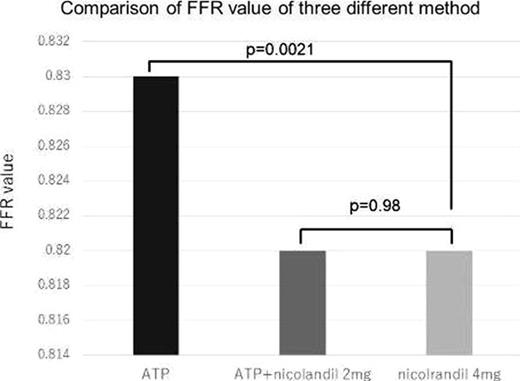-
PDF
- Split View
-
Views
-
Cite
Cite
T Nishikura, K Wakabayashi, N Aizawa, T Suzuki, K Shibata, T Furuya, R Kosaki, H Fukuoka, N Ikeda, M Kikuchi, F Miyoshi, K Tanno, Safety and efficacy of a hyperaemic agent, intracoronary nicorandil 4mg, for invasive physiological assessments during fractional flow reserve measurement, European Heart Journal, Volume 41, Issue Supplement_2, November 2020, ehaa946.1397, https://doi.org/10.1093/ehjci/ehaa946.1397
Close - Share Icon Share
Abstract
Fractional flow reserve (FFR) is one of most reliable index for the determining the functional severity coronary artery stenosis. Adenosine is the most commonly used agent for maximal hyperaemia. However, adenosine can cause chest discomfort, bronchial hyper-reactivity, and atrioventricular block. The aim of this study is to evaluate the safety and efficacy of intracoronary nicorandil as an alternative hyperaemic agent for FFR.
We enrolled consecutive 82 patients (87 lesions) who underwent FFR measurement in our center from Nov. 2018. We compared three groups; intravenous infusion of adenosine (150 μg/kg/min); and adenosine added intracoronary nicorandil 2mg; and intracoronary nicorandil 4mg. Mean FFR value was 0.83±0.09, 0.82±0.09, 0.82±0.08, There was a strong correlation among three groups (R2>0.9). Mean cyclic change in FFR was 0.026±0.023, 0.019±0.010, 0.016±0.014, respectively, cyclic change was smallest in intracoronary nicorandil 4mg group (vs ATP; p<0.001, vs ATP + nicorandil 2mg; p<0.001). By Wilcoxon test, mean FFR value of nicorandil 4mg was significant lower than ATP (p=0.0021), and equal to ATP + nicorandil 2mg (p=0.98).
Intracoronary nicorandil 4mg is a simple, safe, and effective way to induce steady-state hyperaemia for FFR.

Figure 1
Type of funding source: None



